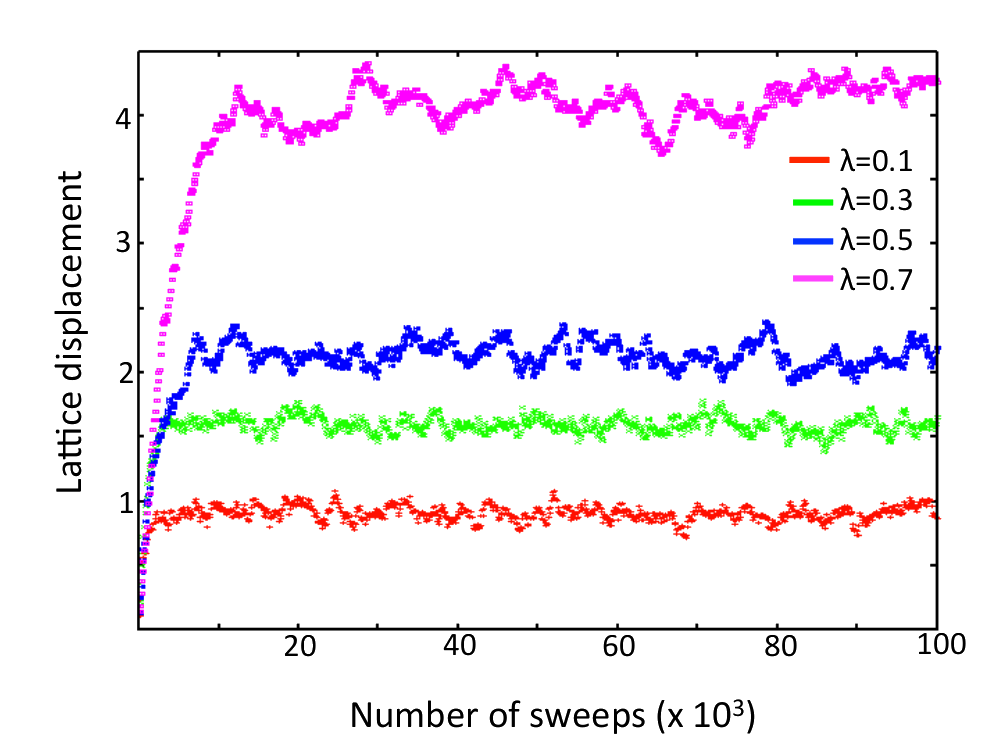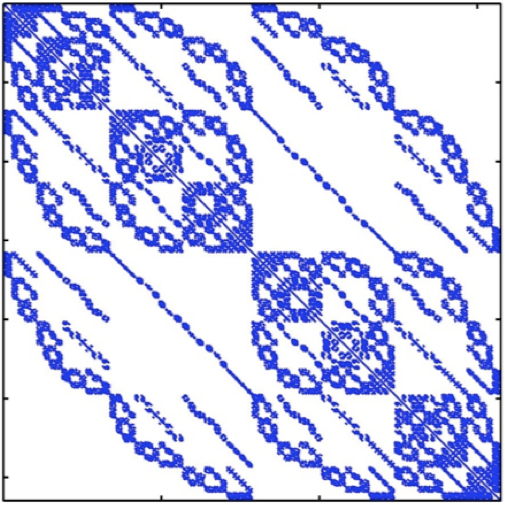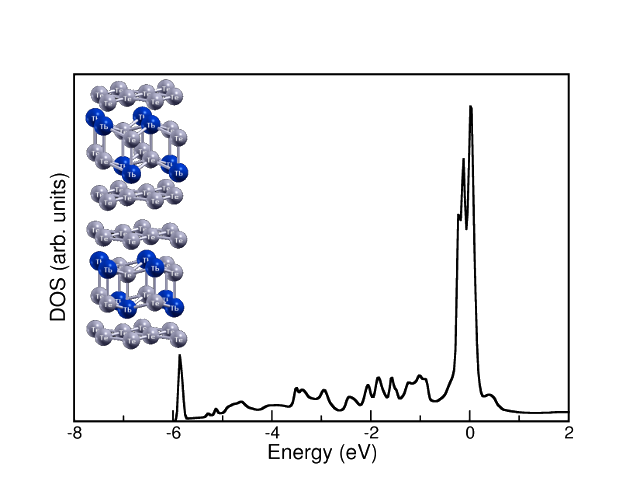Computational Methods
Nonequilibrium Keldysh

Schematic of the Keldysh contour used in our formalism. Time runs from some tmin, out to a tmax and back again, then down the imaginary time spur to account for finite temperature effects on the system in equilibrium. The red and blue curves represent the application of a transient pump pulse at some time after tmin and a subsequent probe pulse, like that used in time-resolved optical spectroscopy or photoemission.
References and Further Reading
- L. P. Kadanoff and G. Baym, Quantum Statistical Mechanics (Benjamin, New York, 1962).
- J. Rammer and H. Smith, Rev. Mod. Phys. 58, 323-359 (1986).
- J. K. Freericks, V. M. Turkowski, and V. Zlatic, Phys. Rev. Lett. 97, 266408 (2006).
- J. K. Freericks, Phys. Rev. B 77, 075109 (2008).
- J. K. Freericks, H. R. Krishnamurthy, and Th. Pruschke, Phys. Rev. Lett. 102, 136401 (2009).
- A. P. Jauho and J. W. Wilkins, Phys. Rev. B 29, 1919-1938 (1984).
Quantum Monte Carlo
 A plot of the value of the displacement field as a function of Monte Carlo step for a simulation of the Hubbard-Holstein model
as a function of electron-phonon coupling λ. Here one sees the initial, rapid, warm-up followed by the fluctuations of the
displacement around some central value as a function of Monte Carlo step. Using determinant quantum Monte Carlo (QMC or DQMC)
and maximum entropy (MEM) analytic continuation one may determine the single-particle spectral function and multi-particle response
functions, like the charge and spin susceptibilities and optical conductivity, as a function of real frequency. From the QMC
process, one also can determine the single-particle filling, static (thermal) charge and spin susceptibilities, and in principle
correlation lengths and even transition temperatures when used as impurity solvers in DMFT and its cluster extensions and through
finite-size scaling.
A plot of the value of the displacement field as a function of Monte Carlo step for a simulation of the Hubbard-Holstein model
as a function of electron-phonon coupling λ. Here one sees the initial, rapid, warm-up followed by the fluctuations of the
displacement around some central value as a function of Monte Carlo step. Using determinant quantum Monte Carlo (QMC or DQMC)
and maximum entropy (MEM) analytic continuation one may determine the single-particle spectral function and multi-particle response
functions, like the charge and spin susceptibilities and optical conductivity, as a function of real frequency. From the QMC
process, one also can determine the single-particle filling, static (thermal) charge and spin susceptibilities, and in principle
correlation lengths and even transition temperatures when used as impurity solvers in DMFT and its cluster extensions and through
finite-size scaling.
References and Further Reading
- R. Blankenbecler, D. J. Scalapino and R. L. Sugar, Phys. Rev. D, 24, 2278-2286 (1981).
- S. R. White et al, Phys. Rev. B 40, 506-516 (1989).
- E. Gull et al, Rev. Mod. Phys. 83, 349-404 (2011).
Richard Scalettar's How To Guide
Richard Scalettar's Homepage
Useful notes from Richard Scalettar's Michigan Quantum Summer School 2010
Exact Diagonalization

A schematic representation of a Hamiltonian in matrix form. The system in question has been represented by a Hilbert space with 1028 elements. The blue dots represent non-zero entries in the Hamiltonian matrix with the remaining elements (white space) equal to zero. The sparsity of this representation makes matrix methods like Lancozs or implicitly restarted Arnoldi and packages like ARPACK and PARPACK ideal candidates for finding the eigenvalues and eigenvectors of this Hamiltonian. Krylov subspace time-evolution may be employed to efficiently determine time-evolved states for out-of-equilibrium, time-domain problems with either a quantum quench of Hamiltonian parameters, or time-translation symmetry breaking from interaction with time-dependent applied fields.
References and Further Reading
- R. B. Lehoucq, D. C. Sorensen, and C. Yang, ARPAC Users' Guide: Solution of Large-Scale Eigenvalue Problems with Implicitly Restarted Arnoldi Methods, SIAM: Software, Environments, and Tools 6 (1998).
- C. Moler and C. van Loan, Ninteen Dubious Ways to Compute the Exponential of a Matrix, Twenty-Five Years Later, SIAM Review 45, 3-49 (2003).
- S. R. Manmana, A. Muramatsu, R. M. Noack, AIP Conf. Proc. 789, 269-278 (2005).
- M. Balzer, N. Gdaniec, and M. Potthoff, J. Phys.: Condens. Matter 24, 035603 (2012).
Dynamical Mean-Field Theory

Cartoon depicting the self-consistency scheme of dynamical mean-field theory (DMFT). In the DMFT scheme one embeds a single-site impurity with full interaction in a non-interacting bath that contains information from the remaining lattice degrees of freedom. Unlike classical Weiss mean-field theory, the effective mean-field function retains dynamical or temporal information about quantum fluctations of degrees of freedom between the impurity site and the bath. DMFT can be extended by considering the embedding of a finite-size cluster in an effective medium in which case the mean-field function depends upon spatial or momentum-space degrees of freedom in addition to the temporal or frequency dependence.
References and Further Reading
- A. Georges et al, Rev. Mod. Phys. 68, 13-125 (1996).
- Th. A. Maier et al, Rev. Mod. Phys. 77, 1027-1080 (2005).
Strongly Correlated Materials: Insights from Dynamical Mean-Field Theory
Lecture notes on the LDA+DMFT approach to strongly correlated materials
Mark Jarrell's Webpage
Density Functional Theory

Determination of the total density-of-states (DOS) for TbTe3 from the ab initio (DFT/LAPW+LO) program WIEN2k. TbTe3 consists of a pair of staggered, parallel, flat Te sheets separated by a pair of staggered, corrugated Tb-Te layers. In principle these ab initio methods can be used to determine the crystal structure, orbitally projected DOS and bandstructure, and phonon spectrum in a materials specific fashion. The results can be compared to STM, ARPES, optical, and various x-ray scattering experiments.
References and Further Reading

































































Connect with Me